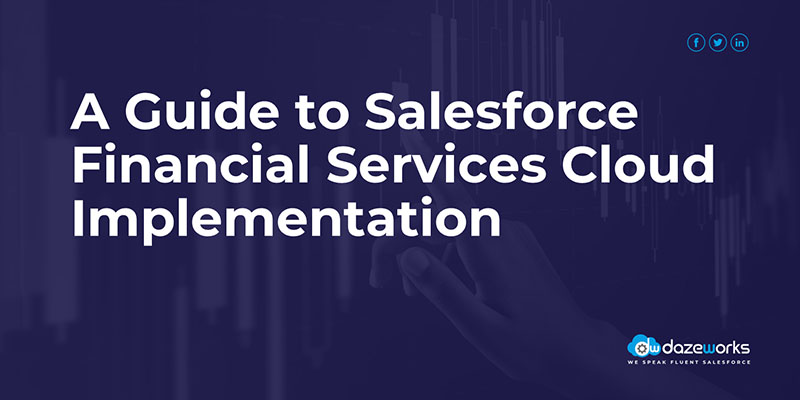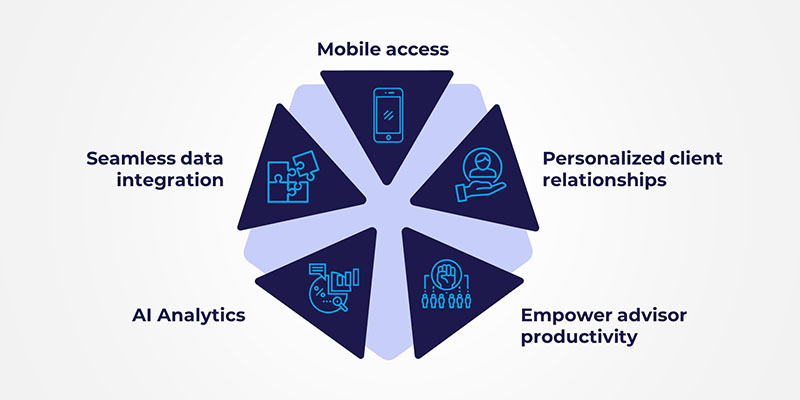
A Guide to Salesforce Financial Services Cloud Implementation
minutes read
The worldwide finance cloud market is speculated to be valued at $101.71 billion by 2030. While many companies are making the move to the cloud, questions such as ‘where to start and what will be the next step’ get in the way. Additionally, many organizations find the migration so arduous that they are often postponed or entirely forgone. The huge financial risk at hand also plays a key role in cloud resistance. Agreeably, implementing a Financial Services Cloud like Salesforce is a big task, but it’s about choosing the right practices. Here are some common practices that will make cloud adoption more seamless.
An Organized Approach Towards Data Migration
Considering the massive amount of data the financial industry works with, a proper data migration strategy is the bedrock of this transformation. You can streamline the workload by dividing it into phases.
- Assessment: This phase involves cost evaluation, modernization, and deployment of tools. User patterns and all elements must be closely examined to make sure workloads achieve the expected success post-migration.
- Development: The companies will update many of their assets that support their workload to capitalize on the potential of the cloud.
- Release: In this phase, the workload will be tested thoroughly to identify the need for any optimization. Thereafter, the progress is documented and released for operations.
Dividing the Roles and Responsibilities
Migration to the cloud implies the introduction of some newer roles and responsibilities into your work culture. Along with considering responsibilities for a particular role, you must also consider people or teams within the hierarchy who can effectively handle the role.
Empower your Employees
Proper planning is key to the successful implementation of the Financial Services Cloud. You should implement stringent change management procedures to empower all employees with the required skills to thrive in a new cloud-centric environment. It’s time to move away from a silos mentality and imbibe a more holistic approach. From the outset, leaders must work with the employees and help them understand the goal behind the prioritization of certain applications over others. A transparent decision-making process will enable you to make the transition more seamless.

Potentials of Salesforce Financial Services Cloud
For Banking and Lending
Engagement in banking and lending institutions is primarily based on relevant insights and communication across various devices. The Financial Services Cloud enables you to easily assess and track customer relationships, streamline the process and coordinate among stakeholders. It helps companies to achieve these benefits by:
- Automating and tracking commercial lending progress
- Forecasting requests for member services
- Standardizing next-level customer care
- Complying with regulatory changes in consumer mortgages and lending
For Capital Market
Salesforce Financial Services Cloud can empower capital firms with robust workflow tools that will help them to align their processes. For instance, the opportunity management feature can help bankers track their investments and deals. Some of the key advantages of the Financial Services Cloud for capital firms include:
- Deployment of artificial intelligence to boost competitiveness
- Build a solid analytics program that offers key insights
- Strict compliance with data and security regulatory requirements
For Insurance Companies
Salesforce Financial Services Cloud assists companies to meet the unique requirements of policyholders. Agents and reps can use 360-degree views of policyholders’ milestones. They can also access real-time analytics, dashboards, and insights to provide personalized coverage recommendations. It helps insurance providers to:
- Streamline onboarding activity workflow
- Provide best offers to customers
- Simplify post and pre-transaction customer journeys
- Offer 360-degree customer view via AMS/PAS integration
For Wealth and Asset Management
Salesforce Financial Services Cloud enables Wealth and Asset Management companies to make sure of trust and transparency. They can use Relationship Intelligence to gather and show the latest account data within and across clients, networks, and households. Some of the key advantages of the Financial Services Cloud for wealth and asset management include:
- Access to tools that offer customized suggestions across various channels
- Achieve stronger insights into financial accounts integration
- Automate householding to offer better client insights
- Powerful marketing automation to optimize the time invested in helping clients accomplish their goals.
Successful implementation of the Financial Services Cloud would pave the way for reduced operational costs and increased business value. This is because when companies are empowered with better data it results in more strategic decisions.
